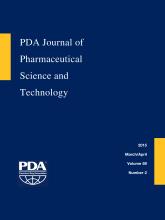Abstract
Purpose: This study investigates the validity, reliability, and detection limit of a visual examination method utilizing the Tyndall effect to enhance visible detection of particles. The suitability of the method for compatibility testing of intravenous fluids in a hospital pharmacy context is discussed.
Methods: A panel of 20 inspectors examined 20 samples, with and without particles, using two light sources (halogen lightbulb in a focused desk lamp and a red pocket laser pointer). The samples contained particles of different origin (precipitate, polystyrene standards), varying size, and concentrations. Light obscuration and turbidimetric measurements were used to obtain numeric references. The samples were divided into rejection probability zones, and the validity (sensitivity, specificity, and likelihood ratios) and reliability (inter-rater agreement coefficients Fleiss' kappa and Gwet's AC1) were estimated.
Results: The sensitivity of the laser pointer for detecting microprecipitates was quite high; however, it also showed a high false rejection rate. The specificity was slightly higher for the focused desk lamp than the laser pointer. The likelihood ratios were not within the recommended limits of a useful test, indicating that the method could not securely confirm the presence/absence of particles in the samples. The inter-rater agreement coefficients indicated fair to moderate agreement between the inspectors.
Conclusions: The validity and reliability were not satisfactory for either of the light sources. The visual detection limit seemed to be around 5 μm, although we propose that an exact detection limit is not that relevant for compatibility testing. Based on the current findings, the visual examination method cannot be recommended as the sole method for judging compatibility of parenteral nutrition and drugs, but rather in a program of several methods. In the hospital pharmacy, the method may be a resource, together with theoretical considerations, in situations where other methods are unavailable; however, use of in-line-filters is essential to protect the patient.
LAY ABSTRACT: Many patients under intensive care are in need of several intravenous drugs simultaneously. These drugs cannot be given in the same infusion line unless compatibility has been documented. Incompatibilities can result in, for example, precipitation of particles. Injected particles can harm the patient and should be avoided. Visual screening of blends of drugs for possible incompatibility, using a focused light source to enhance visual detection based on the Tyndall effect, could be a quick and easy methodology to identify incompatibility. In the following study the objective was to investigate how reliable visual inspection, with the utilization of the Tyndall effect, is at detecting particles and precipitations in blends of intravenous drugs and parenteral nutrition mixtures. Twenty inspectors each examined 20 different samples with two different light sources. Some of the samples were without particles (clean), and some contained different types and degrees of particle contamination. The inspectors' judgment of the samples was recorded and validity and reliability parameters were calculated to evaluate the method's suitability. The conclusion was that because of false positive and negative findings the visual inspection method alone is not enough to securely document compatibility/incompatibility, but it is more suitable as support together with additional methods.
- Sub-visual particles
- Total parenteral nutrition
- TPN
- Parenterals
- Inter-rater Reliability
- Incompatibility
- PocketLaser pointer
- © PDA, Inc. 2015
PDA members receive access to all articles published in the current year and previous volume year. Institutional subscribers received access to all content. Log in below to receive access to this article if you are either of these.
If you are neither or you are a PDA member trying to access an article outside of your membership license, then you must purchase access to this article (below). If you do not have a username or password for JPST, you will be required to create an account prior to purchasing.
Full issue PDFs are for PDA members only.
Note to pda.org users
The PDA and PDA bookstore websites (www.pda.org and www.pda.org/bookstore) are separate websites from the PDA JPST website. When you first join PDA, your initial UserID and Password are sent to HighWirePress to create your PDA JPST account. Subsequent UserrID and Password changes required at the PDA websites will not pass on to PDA JPST and vice versa. If you forget your PDA JPST UserID and/or Password, you can request help to retrieve UserID and reset Password below.






